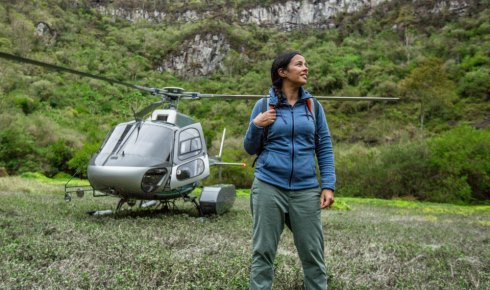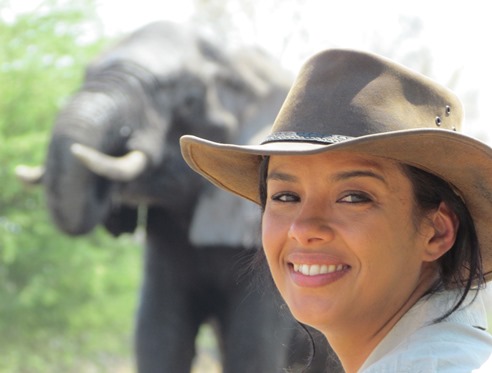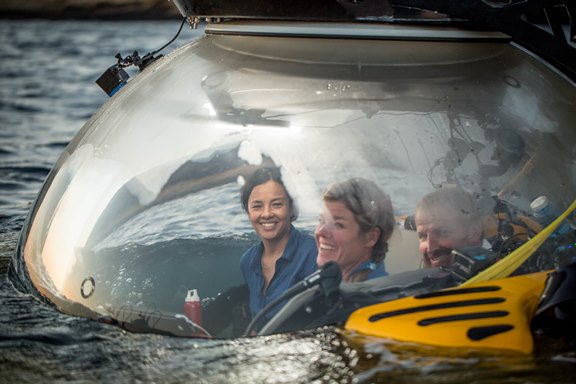"There is a lot of fire in bellies at the moment"

(Images courtesy of Toby Strong and Atlantic Productions)
TV science presenter Liz Bonnin talks to Tom Ireland about her love of biochemistry and big cats, and how she hopes her new documentary will help tackle plastic pollution
The Biologist 65(4) p16-19
Liz Bonnin was born in Paris before moving to Ireland as a child. After studying biochemistry at Trinity College Dublin, a whirlwind showbiz career led to her presenting UK breakfast television and Top of the Pops in the early 2000s. However, she decided to return to her true passion, life sciences, completing a master’s in wildlife biology at the Zoological Society of London and the Royal Veterinary College.
Returning to TV on the award-winning show Bang Goes the Theory, Bonnin has gone on to become a much-loved wildlife and science broadcaster, fronting programmes including Horizon, Stargazing Live and Springwatch, and presenting live from nature reserves in California and Alaska. Her latest project is a film for the BBC on plastic pollution, due to be shown in the autumn.
Your new film is about plastic pollution, a huge and terrifying issue right now. Presumably you’ve seen first hand the impact of discarded plastic when filming at various locations around the world?
That’s right. I’ve filmed from many places and been privy to some pretty depressing realities about the state of local ecosystems, but this plastic project has been so much more difficult to film because it’s just a different ball game in terms of how bad it is and how visible it is. Everything we are filming is completely surpassing my expectations, and not in a good way.
As well as highlighting the awful scale of the problem, it sounds like the programme will be looking at some of the research and innovation that may help us find solutions.
Always one of my main remits is to celebrate the scientists working tirelessly to find a solution. They are the heroes and it’s very humbling to watch what they are doing. As programme makers, we are aware that television storytelling of this ilk has to evolve, because there is no time to waste any more. It’s never wagging the finger, but we want to empower the viewer about what they can do, which is new and exciting. So there is a lot of fire in bellies at the moment. Our mission is to make them feel the way I’m feeling as I’m doing this, which is really motivated to step up and take responsibility for my planet. It goes far beyond giving up straws and using your reusable coffee cup.
Even for people who are aware of the problem, it’s so hard not to end up with a trolley full of plastic every time you go shopping. Do you think governments and industry should do more, rather than asking individuals to try to avoid this ubiquitous material?
Undeniably. I’m halfway through filming and absolutely that is where the things need to change. I think we all know that, ultimately, with conservation issues across the board, that’s where the buck stops. That’s the bit that is difficult to negotiate and communicate in a way that is not too political.
Where did your love of science and nature develop?
I was lucky enough to grow up spending lots of time outdoors. We had a little wood next to our house in the south of France, and I spent a lot of time in the sea as a toddler on trips to the Caribbean. My sister and I used to have adventures with our two dogs, and hedgehogs, snakes and spiders.
What led you to study biochemistry? Presumably you did not have your sights set on a career in television then?
I was fascinated to know how living things worked down to the chemical equations. How do things see? How do I see? I loved biology and chemistry at school.
I’m always at pains to tell children at school not to put too much pressure on themselves to decide exactly what they want to do. I loved my degree, but towards the end I knew it wasn’t quite what I wanted to continue doing. It wasn’t that I wished I’d done a different degree, but I thought that the next bit of my journey would be in conservation and wildlife.
 Liz filming on location in Botswana
Liz filming on location in BotswanaThe next stage of your career got quite crazy quite quickly. You ended up presenting the IRMAs (Irish music awards) ‘by chance’. What happened?
Well, I was singing in a sort of girl band at the time… Dublin’s very small and the person producing the IRMA awards didn’t want a presenter to present them – they wanted to do something a bit different. I tried out for it and got the job, and that led to other jobs and then [Channel 4 breakfast TV show] RI:SE in the UK and then Top of the Pops. It was just this crazy adventure and I never expected it to last too long. I just rolled with it.
You then did a MSc in wildlife biology with the Zoological Society of London and the Royal Veterinary College. What made you turn your back on showbiz to return to university?
There was a point where I wasn’t really enjoying myself any more and missed academia. I took a break and had a ‘eureka’ moment on a mountain in South America – I’m sorry, that sounds like a cliché, but it’s true. I thought “I’m going to go back and study wildlife conservation.” I was accepted on the master’s course, and when it started I began to wonder if I could work in conservation but somehow use the creative storytelling skills from television, which I’d grown to love.
I looked up the agent of my favourite wildlife presenters and told them I was in the middle of my master’s and that my showreel was all entertainment shows. I guess timing is everything, because just as I finished my master’s, Bang Goes the Theory was auditioning and I haven’t looked back since.
What did you learn during your master’s?
It was a seminal moment for me. I dug my heels in and insisted on going to Nepal to do a study on tigers’ diets. It wasn’t working out, to the point where my supervisor and best friends even said: “Liz, you’ve got to let it go” I ended up in tears in a hotel in Kathmandu – none of the equipment I needed had got out there, I was struggling to contact the local scientists and I really thought I would fail the course. Eventually, I made it to the Bardia National Park, carried out my research project and in the end came first in my class. It was a really important life lesson about working hard.
Tell me about your fascination with cats and your most memorable big-cat experience.
There’s something about domestic cats I was obsessed with as a kid. I think it’s because they have retained a lot of their wild traits and they aren’t as domesticated as dogs – you can never quite figure them out.
When I was still working in entertainment television, I did a programme for RTE where I went to Pench National Park in India. To this day, I think that is the most special big-cat experience I’ve had. We met a tigress who was fairly tolerant of people and allowed us to follow her through her territory for about four hours, which is so rare, and she stole my heart. So I knew I would go back to work in conservation and I would do whatever it took to work with tigers again.
What is the current situation in terms of efforts to conserve wild tigers?
Unfortunately, the challenges are the same as ever: our burgeoning human population means tiger habitat and key wildlife corridors are being lost. I did get news from the researchers who helped us with Operation Snow Tiger that numbers are slightly up in that subspecies in the far east of Russia. But we mustn’t be complacent about a few individuals doing well. Tigers are critically endangered and it’s a really sad state of affairs.
Sometimes I do speak to conservationists who say it’s too late: that’s the reality. I don’t know what the answer is. The idea of trying to set aside wild spaces for animals with ranges as large as tigers need doesn’t seem realistic any more. We need to find ways to live alongside them, which is very difficult when they don’t have enough prey and start to encroach on people’s land and animals.
You reported on zoos for a Horizon documentary in 2016. How did you feel, coming away from the programme, about the idea of keeping animals in captivity to help conserve critically endangered species?
I consider myself a member of the zoo community and I wanted to take a long, hard look at the science of how animals are faring [in zoo settings]. We know so much more about how sentient and intelligent some animals are, and what those with large ranges need and what captivity does to them. Then you have to weigh up the argument that zoos could be some kind of repository for a species should they go extinct in the wild. For me, it’s as simple as that – do we have the right to keep an animal in captivity even if it is a safety net, when we know how harmful it is for these species?
The science is telling us it is our responsibility in the zoo community to evolve and make tough decisions. I came away feeling strongly that big animals such as elephants, carnivores with big ranges and apes shouldn’t be kept in captivity. I do not think that if all tigers go extinct in the wild, it is worth keeping them in captivity. They are not suitable for release in the wild after just a few generations and if we can’t secure their habitat now, why would we in the future?
However I came away hopeful about how zoos could evolve. Twycross Zoo in the UK, Detroit Zoo and others are trying to do the right thing – taking a long hard look at what animals need and have even let go of some of their larger animals. I think part of the solution is for zoos to create small ecosystems that showcase insects, plants and maybe even small mammals that do well in captivity. Showing how everything is interconnected in this way has more educational value for visitors than a large animal pacing back and forth in an enclosure. Detroit let go of its elephants and visitorship is on the increase.



